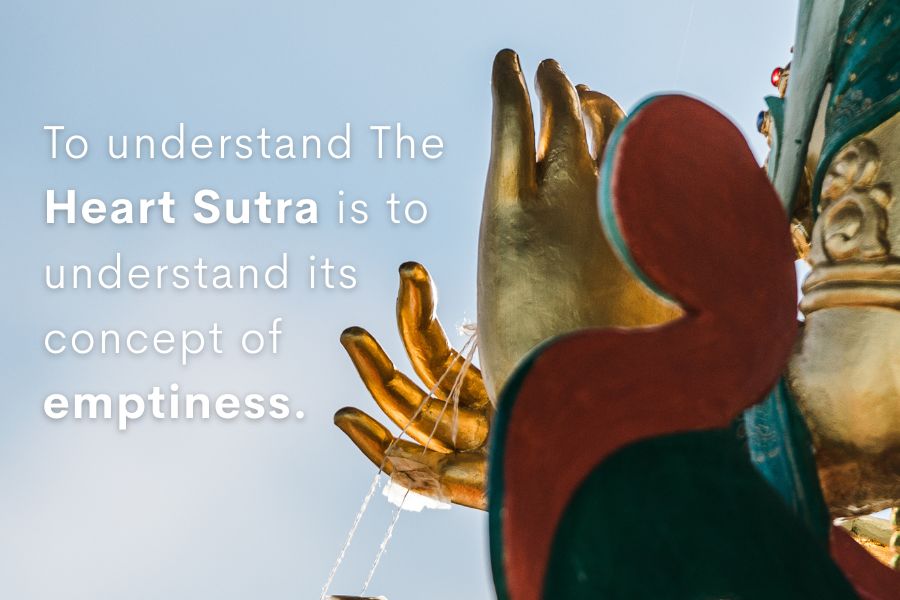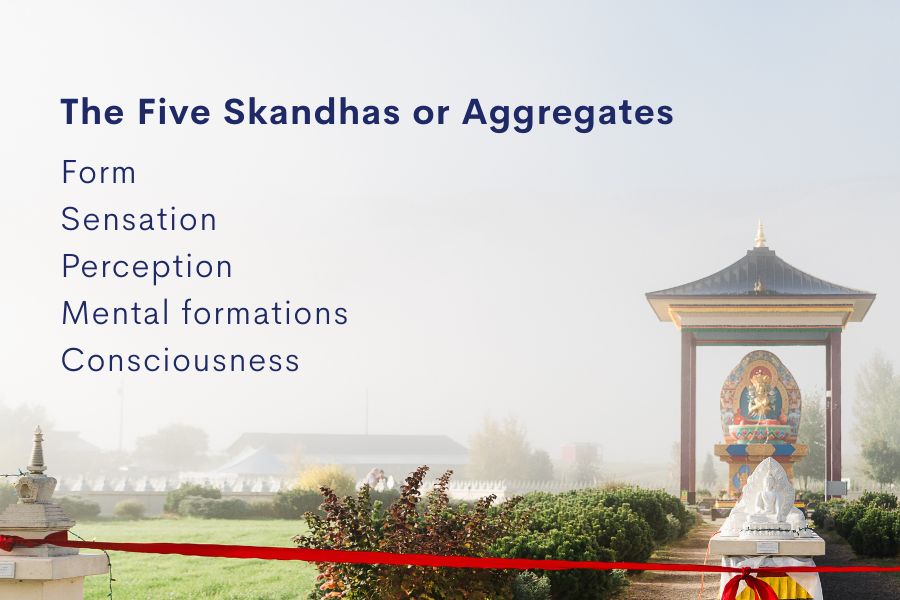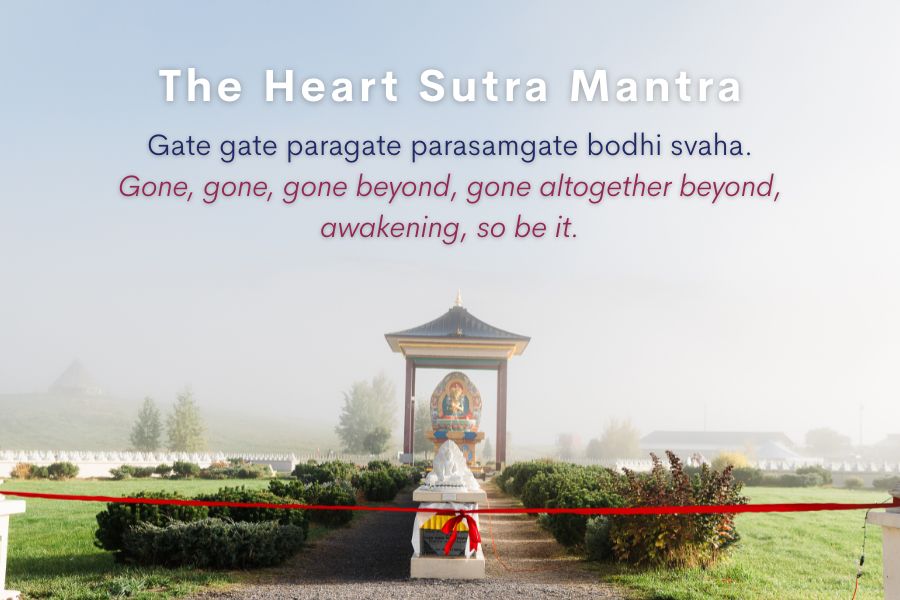The Profound Wisdom of the Heart Sutra:
An Introductory Exploration
Concise, profound, and somewhat enigmatic, the Heart Sutra contains the essence of all Buddha’s teachings and offers insight into life, suffering, and liberation.
Known in full as the “Prajnaparamita Hridaya Sutra,” The Heart Sutra is a short Mahayana Buddhist text – just 14 verses in Sanskrit – that forms a part of the larger Prajnaparamita (Perfection of Wisdom) literature, and is chanted often in Buddhist temples to illuminate the nature of reality. Practitioners and spiritual seekers study it to deepen their understanding of the Dharma.

Emptiness – The Central Teaching of The Heart Sutra
To understand The Heart Sutra is to understand its concept of emptiness (“shunyata”) and the realization that attachment to physical and mental things leads to suffering. It is not, however, a denial of existence nor a nihilistic teaching.
According to the text, nothing is permanent, fixed, or exists in isolation; all objects, concepts, and thought processes are dependent on myriad conditions and factors. Referred to as “dependent origination,” things arise and cease based on interconnected factors. That applies to our bodies, minds, and sense of self, which result from conditions such as our upbringing, environment, and past experiences.
In the Heart Sutra, the bodhisattva Avalokiteshvara elucidates the wisdom of emptiness to Sariputra, explaining that things are empty of inherent existence

The Five Aggregates and the Illusion of Self
The Heart Sutra is a Mahayana Buddhist sutra and a part of what is called the “middle turning of the wheel of dharma.” In the first turning of the wheel of dharma, the Buddha explained that our sense of self is something we imagine in connection with how we view five things, known as the five aggregates. In the Heart Sutra, the teachings continue from this point, showing that not only does the self not truly exist, but neither do the five aggregates that form the basis upon which we imagine the self.
What are the Five Skandhas of the Heart Sutra?
Skandhas is the Sanskrit word for aggregates. Immersed in the practice of the Perfection of Wisdom, bodhisattva Avalokiteshvara perceived the emptiness of the Five Aggregates:
- Form
- Sensation
- Perception
- Mental formations
- Consciousness
Together, the Five Aggregates constitute the human experience. Avalokiteshvara discovered that emptiness is not a nihilistic void but is the very nature of all things, both physical and mental, showing that all phenomena lack any fixed essence.
The sutra says that none of the aggregates have inherent existence because they are impermanent, interdependent, and empty of intrinsic nature – challenging our attachment to a fixed identity.
The Cessation of Suffering
The Heart Sutra goes on to say that in emptiness, there is no suffering, cause of suffering, cessation of suffering, or path to the cessation of suffering. In essence, the concepts of suffering and liberation are empty. Transcending The Four Noble Truths – the foundational teaching of Buddhism – we learn there is nothing to attain and no one to attain it – the ultimate truth of emptiness.
The Heart Sutra Mantra
The Heart Sutra’s conclusion is a powerful encapsulation of the journey from ignorance to enlightenment. Chanting the mantra – “Gate gate paragate parasamgate bodhi svaha” (“gone, gone, gone beyond, gone altogether beyond, awakening, so be it”) – helps us connect with the energy of wisdom and compassion.
How many times do you chant the Heart Sutra?
There is no particular number of times to chant the mantra. Many Buddhists recite it daily.

Deciphering Key Phrases in The Heart Sutra
Many people take quotes from the Heart Sutra. Here’s a sampling of popular quotes.
Form is Emptiness; Emptiness is Form: Physical things (“form”) are empty of inherent existence and emptiness is present in every form. The sutra goes on to say that the same applies to sensation, perception, mental formations, and consciousness. To achieve enlightenment, the Heart Sutra teaches us to recognize that the five aggregates and emptiness are inseparable.
No eye, ear, nose, tongue, body, mind: Though all phenomena are included in the five aggregates, the sutra goes on showing the emptiness of all categories of phenomena, of both our senses, the objects of our senses, and so forth.
No suffering, no cause of suffering, no cessation of suffering, no path: We may feel okay in saying that our minds, senses, sense objects and so forth are empty, but what about the basic truths of Buddhadharma, such as the Four Noble Truths? The Heart Sutra teaches us that suffering (“dukkha”), its causes, its cessation, and the path to its cessation are empty of inherent existence.
No wisdom, no attainment, and no non-attainment: Okay, maybe we can accept that even the Four Noble Truths are emptiness because they are a part of the path, but what about the wisdom which is the result of the path? Heart Sutra teaches that even wisdom is empty of inherent existence. In stating that there is no attainment and no non-attainment the Heart Sutra challenges our dualistic tendency to want to jump to the conclusion that if there is no attainment, then that must imply that there is non-attainment. The Perfection of Wisdom is beyond all concepts.
Enlightenment, therefore, is realizing the emptiness of all things.
Therefore, the Bodhisattva…relies on the perfection of wisdom, and the mind is without hindrance: When we rely on the perfection of wisdom, the realization of emptiness, our mind is free of hindrances such as attachment, aversion, and ignorance. This allows
us to act with compassion and wisdom – helping all beings to achieve liberation.
Four Ways to Apply the Heart Sutra to Our Lives
The Heart Sutra is a practical guide for meditation and daily life. By contemplating emptiness, we develop an open-mindedness, free from prejudices and attachments. By reflecting on the emptiness of the five aggregates, we loosen our identification with ego. This can lead to a transformation of consciousness and a path to greater wisdom and compassion. Here are some ways to connect the sutra to our modern lives:
1) Accept Interconnectedness: Once you accept that everything is interconnected, you realize how your actions impact others, helping you to cultivate more care in how you conduct yourself. Recognizing interdependence can also reduce feelings of separation and isolation.
2) Cultivate compassion: When you see the world through the lens of emptiness and interconnectedness, you remember that everyone is what they are through various causes and conditions and no one is fixed or stuck in being what we think they are. This helps cultivate compassion.
3) Let go of attachment: The lesson of emptiness teaches us that nothing is permanent or inherently existent and that fixating on possessions, relationships, and ideas leads to suffering. When we practice non-attachment, we can reduce our suffering and feel a sense of peace and freedom.
4) Find the path to wisdom and liberation through direct experience: Grasp the truth through direct experience. The sutra teaches that the wisdom of emptiness is not understood through intellectual or conceptual thinking; it must be realized in meditation and mindful living.
The Heart Sutra has many relevant applications to modern life. It challenges consumerism and individualism and reminds us that happiness is not found in possessions or achievements. Teaching us to see the emptiness of fixed identities helps us cultivate greater compassion for others, leading to harmony and cooperation. A timeless masterpiece of spiritual wisdom, the Heart Sutra is a guide to living a life of compassion and inner peace.
To continue exploring, check out the following videos:
- Exploring the Heart Sutra Series Dharma talks with teacher and translator Justin Kirkwood.
- Emptiness with Namchak Khen Rinpoche
- Commentary for Emptiness teaching: Instructions on Practising Fourfold Emptiness
